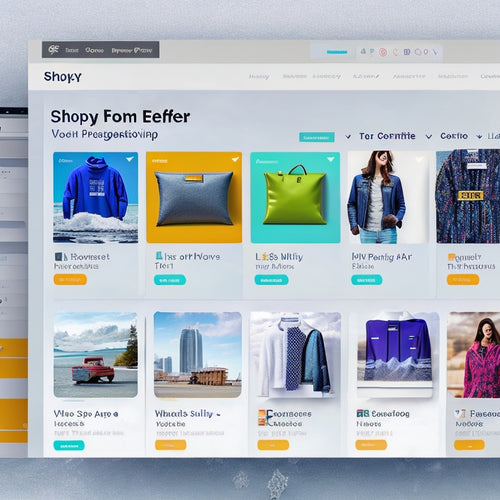Understand How the Algorithm Works
Share
This article examines the intricate relationship between algorithms and shoppable videos, exploring how these technological tools work together to enhance the shopping experience.
By delving into the rise of shoppable videos in social media and the role of data collection in personalizing recommendations, we gain a deeper understanding of how algorithms drive this emerging trend.
Through an analytical and technical lens, this article explores the future implications of algorithmic technology on shoppable videos, offering insight for those seeking to belong in this ever-evolving digital landscape.
- Algorithmic advertising in shoppable videos leverages machine learning algorithms to optimize ad placements based on user demographics and browsing history.
- Computational techniques play a significant role in creating highly engaging and personalized interactions in shoppable videos.
- Analytics-driven algorithms enhance targeting capabilities, improve ad effectiveness, and increase customer engagement in shoppable videos.
- Algorithmic technology in shoppable videos holds immense potential to transform online shopping experiences, enhance user engagement, and drive business growth.
The Rise of Shoppable Videos in Social Media
The emergence of shoppable videos on social media platforms has become increasingly prevalent in recent years. These videos seamlessly integrate e-commerce capabilities into the video content, allowing viewers to make purchases directly from the video itself. This innovative approach has had a significant impact on consumer behavior and presents numerous challenges for businesses implementing this technology.
Shoppable videos have revolutionized consumer behavior by transforming passive viewers into active participants in the shopping experience. By providing direct links to products within the video, consumers can easily explore and purchase items without leaving the platform. This convenience and immediacy have led to increased impulse buying, as consumers can quickly act upon their desire for a product while watching a video.
However, implementing shoppable video technology comes with its own set of challenges. One major hurdle is ensuring seamless integration between the video content and e-commerce platforms. The technical aspects of syncing product information, inventory management, and transaction processing require careful consideration to provide users with a smooth online shopping experience.
Furthermore, businesses must also address privacy concerns when implementing shoppable videos. As these videos collect user data for personalized recommendations and targeted advertising, companies need to ensure transparency in how this data is used and protected.
In conclusion, shoppable videos have had a profound impact on consumer behavior by offering an immersive shopping experience directly within social media platforms. However, businesses must overcome various challenges associated with technical implementation and privacy concerns to fully capitalize on this emerging trend in digital marketing strategies.
How Algorithms Power Personalized Recommendations
Algorithms utilize user data to generate personalized recommendations for individuals. In the context of shoppable videos, recommender systems play a crucial role in enhancing user experience by suggesting products that align with their preferences. These algorithms analyze user behavior and preferences, such as click-through rates, purchase history, and interactions with content, to generate tailored recommendations.
-
Collaborative filtering: This approach compares a user's preferences with those of other users who have similar tastes. By identifying patterns and similarities among users' behaviors, the algorithm can recommend products that others with similar interests have found appealing.
-
Content-based filtering: This technique focuses on analyzing the characteristics of items themselves rather than relying solely on user behavior. It considers attributes like product descriptions, tags, and categories to identify items that are likely to be of interest based on an individual's past choices.
-
Hybrid approaches: Some recommender systems combine collaborative filtering and content-based filtering techniques to provide more accurate and diverse suggestions. By leveraging both user behavior and item characteristics simultaneously, these hybrid algorithms can overcome limitations inherent in each individual method.
These algorithms continuously learn from user feedback and adapt recommendations accordingly. As a result, users receive personalized suggestions that match their unique tastes and preferences while promoting a sense of belonging within online communities.
The Role of Data Collection in Shoppable Videos
Data collection plays a crucial role in enhancing user experience and tailoring recommendations in the context of personalized suggestions for online shopping. Shoppable videos, which integrate interactive features with video content, rely on data collection to provide users with relevant and personalized product recommendations. However, this practice raises concerns about data privacy and ethical implications.
In order to deliver personalized recommendations, shoppable video algorithms collect various types of user data, such as browsing history, purchase behavior, and demographic information. By analyzing this data, algorithms can identify patterns and preferences that help improve the accuracy of product suggestions. This enables users to discover products that align with their individual tastes and interests.
While data collection is essential for optimizing user experience, it also raises important ethical considerations. The gathering and analysis of personal data must be conducted within legal boundaries and with utmost respect for individuals' privacy rights. It is crucial for companies to prioritize transparency by clearly communicating their data collection practices to users and obtaining informed consent.
Furthermore, organizations must take steps to safeguard collected data from unauthorized access or misuse. Implementing robust security measures ensures that user information remains protected throughout the entire process of recommendation generation.
Overall, while data collection is integral to the success of shoppable videos in providing tailored recommendations, it is essential for companies to address the ethical implications associated with privacy concerns. Striking a balance between personalization and protecting user privacy will contribute to building trust among consumers in this evolving landscape of online shopping experiences.
Enhancing the Shopping Experience through Algorithms
By employing sophisticated computational methods, online retailers can enhance the shopping experience for users through the application of intelligent algorithms. These algorithms enable personalized advertising and algorithmic product placement, allowing retailers to tailor their offerings to individual users based on their preferences and browsing behavior. This level of personalization creates a sense of belonging for users by presenting them with products that align with their interests and needs.
Here are five ways in which algorithms enhance the shopping experience:
-
Recommender Systems: Algorithms analyze user data to generate personalized recommendations, suggesting products that users are likely to find appealing.
-
Dynamic Pricing: Algorithms adjust prices in real-time based on various factors such as demand, competition, and customer behavior, ensuring customers receive fair pricing.
-
Visual Search: By leveraging computer vision technology, algorithms enable users to search for products using images rather than keywords, simplifying the shopping process.
-
Augmented Reality (AR): Algorithms integrate AR technology into shoppable videos, allowing users to virtually try on or visualize products before making a purchase decision.
-
Social Shopping: Algorithms facilitate social interactions within e-commerce platforms by recommending products based on friends' purchases or displaying popular items among a user's social circle.
These advancements in algorithmic techniques not only improve the efficiency of online shopping but also create an engaging and personalized experience for customers, fostering a sense of connection and satisfaction.
The Future of Shoppable Videos and Algorithmic Technology
The future of online shopping is expected to witness a significant transformation with the integration of advanced computational techniques and technology, resulting in enhanced user experiences. Shoppable videos, combined with algorithmic advertising, are poised to revolutionize the way consumers interact with products and make purchasing decisions.
Shoppable video analytics enable marketers to track consumer behavior within videos, providing valuable insights into engagement levels, product preferences, and conversion rates. By analyzing this data, algorithms can generate personalized recommendations tailored to individual users' interests and needs. This targeted approach enhances the shopping experience by presenting relevant products in real-time while users watch videos.
Algorithmic advertising further complements shoppable videos by leveraging machine learning algorithms to optimize ad placements based on user demographics, browsing history, and previous purchase behavior. These algorithms continuously analyze vast amounts of data to identify patterns and trends that allow for more accurate targeting of potential customers.
In addition to improving user experiences, algorithmic technology also benefits businesses by increasing brand exposure and driving sales. The ability to deliver hyper-personalized content ensures that advertisements are more likely to resonate with viewers, increasing the likelihood of conversions.
Overall, the future of shoppable videos and algorithmic technology holds immense potential for transforming online shopping experiences. By harnessing advanced computational techniques and analytics-driven algorithms, businesses can create highly engaging and personalized interactions that cater specifically to their target audiences' preferences.
Frequently Asked Questions
How do shoppable videos affect consumer behavior and purchasing decisions?
Shoppable videos have a significant impact on consumer behavior and purchasing decisions. They enhance consumer engagement by providing interactive experiences, leading to higher conversion rates. Shoppers are more likely to make purchases when they can directly interact with products within the video.
What types of data are collected in shoppable videos to personalize recommendations?
Personalization techniques in shoppable videos rely on data driven recommendations. Various types of data are collected, such as user demographics, browsing history, purchase behavior, and social media engagement. This allows for tailored product suggestions to enhance the consumer experience.
Are shoppable videos only available on certain social media platforms?
Shoppable videos are available on various social media platforms, such as Instagram, Facebook, and YouTube. These platforms provide the necessary infrastructure for users to create and share shoppable content, increasing the availability of this interactive shopping experience.
Can algorithms predict trends and suggest products that consumers may be interested in?
Algorithms in the fashion industry have a significant impact through personalized recommendations. By analyzing consumer data, algorithms can predict trends and suggest products that align with individual preferences, enhancing the shopping experience and increasing customer satisfaction.
How do algorithms in shoppable videos enhance the overall shopping experience for consumers?
Algorithms in shoppable videos enhance the overall shopping experience for consumers by enhancing engagement and increasing conversion rates. They achieve this by providing personalized recommendations, seamless integration of product information, and interactive features that facilitate decision-making and a sense of belonging in the shopping process.
Related Posts
-
Enhance Shopping Experience With Shareclips: The Ultimate Shoppable Video Solution
ShareClips is a revolutionary platform that revolutionizes the shopping experience by offering a convenient and innov...
-

Streamlining Your Business: The Power of Shopify ERP Integration
The integration of Shopify with ERP software offers a powerful solution for businesses, automating various processes...
-

What Is App Integration in Shopify
App integration in Shopify refers to the process of incorporating external applications into the Shopify platform to...

